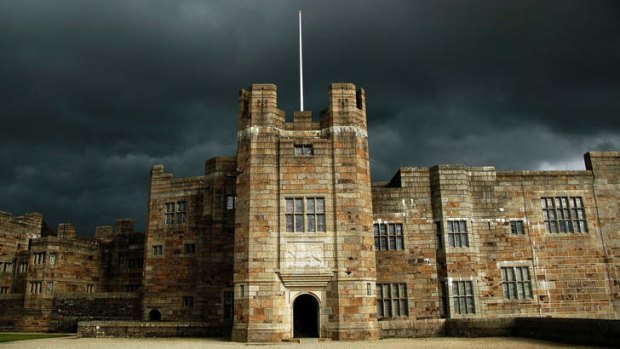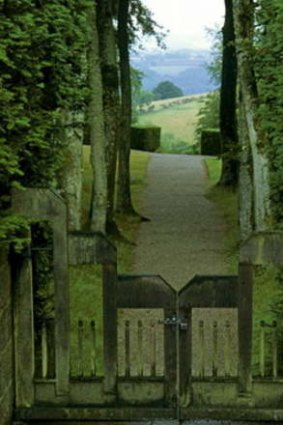
Castle Drogo's damp past.Credit: Alamy
Margaret Turton explores a majestic Devon mansion filled with extravagances that were way ahead of their time.
British designer and television presenter Kevin McCloud is not the first to be obsessed with sharp, innovative design for domestic dwellings. The celebrated architect to the British Empire, Sir Edwin Lutyens (who spread visions of Englishness as far as New Delhi) designed a castle in Devon and filled it with modern gadgetry for his wealthy client, Julius Drewe.
Castle Drogo - the last grand castle constructed in England - is a mediaeval vision with up-to-date conveniences and an art deco edge.

Right path...the rolling hills of Devon.Credit: Alamy
Nothing was too extravagant for the owner of Home and Colonial Stores, an immensely successful British retail chain. Drewe's budget was £60,000 for the castle and its grounds, a whopping figure in 1911, when the foundation stone was laid.
The ambitious grocer with money to burn was determined to raise his social position through the creation of a substantial "family seat". The architect was held in high esteem, spoken of in almost reverent tones. What could possibly go wrong with this building project?
Well, anyone who has watched McCloud's television series, Grand Designs - or done their own home reno, for that matter - knows that a build can go off the rails at any minute.
Castle Drogo's plans called for the architectural eccentricities of a mediaeval castle, including a fully operational portcullis (lattice-grilled fortified door) at the entrance tower. And rows of decorative inverted crosses perforating castellated walls; not easily executed when carving through Dartmoor granite, the hardest stone in England.
The same goes for the effort of installing 332 plug sockets and electric wiring into thick internal walls to provide the array of devices and gadgets with energy, powered by Lutyens-designed hydro-turbines.
Further innovations include the artificial candles that were lit with the aid of an electrically wired tablecloth in the formal dining room. Lutyens also designed bathrooms with ultra-modern plumbing, and planned every detail of the kitchen - where spacious preparation areas flooded with natural light would make a MasterChef team gasp with wonder. Then there's the butler's pantry with its crafted-oak servants' bell board and a telephone exchange for the 18 in-house telephones.
Progress went smoothly enough - apart from budget blow-outs and major interruptions caused by the First World War. There was also an issue with the roof.
Castle Drogo's roof is flat, and Lutyens sealed it with a new and promising product, asphalt. The choice seemed superbly practical at the time but it turned out to be a costly error of judgment that set the scene for many future calamities.
Contraction and expansion of the roof's concrete slabs caused the asphalt to split. Every subsequent generation of Drewes was plagued by water damage and costly repair bills.
Finally, in 1973, a frustrated grandson wrote a one-sentence letter offering Castle Drogo to the care of the National Trust, resulting in the opportunity to observe the Drewe-Lutyens innovations today.
As I wander through the retail magnate's fantasy castle, the thing I notice is the property's enormous scale, and its clean sharp lines. It's not surprising that skilled stonemasons were kept busy for almost two decades.
It's also clear that Drewe's every whim was indulged in the quest for social mobility. And no doubting the dynastic feel achieved with traditional timberwork, great stone fireplaces and torches set against the smooth granite walls.
But there is something of the Hollywood stage set about this property. Billy Wilder's film noir classic, Sunset Boulevard - essentially a tale of ego, fantasy and decline - springs to mind.
And that's what Castle Drogo has come to illustrate, really. Aside from the disintegrating roof, there were day-to-day problems with devices and gadgets. Voltage delivered to Castle Drogo's switch room from the Lutyens-designed hydro-turbines was capricious. The coal-fired central heating system was unreliable.
Worse was the sobering fact that the rise of this British grocer precisely coincided with a time of enormous social change. Even before his grand project was completed, World War I caused Britain's class system to unravel, and the prospect of acquiring staff to maintain an establishment such as Castle Drogo became a huge and unyielding challenge.
The end of an era was nigh and, in time, the end of the British Empire itself.
THE STATELY SIDE
National Trust properties near Torquay include:
High Cross House Dartington, near Totnes, built in 1932 by Swiss-American architect William Lescaze. It is showcasing contemporary art. Entry £8 ($7.20). Phone +44 1803 842 382, see nationaltrust.org.uk/high-cross-house.
Coleton Fishacre, Brownstone Road, Kingswear, an elegant holiday home of the D'Oyly Carte family, built in the Arts and Crafts style. Entry £9.90. Phone +44 1803 752 466, see nationaltrust.org.uk/coleton-fishacre.
Bradley Manor, Newton Abbot, a mediaeval manor with pre-Raphaelite drawings and art nouveau textiles. Entry £5. Phone +44 1803 661 907, see nationaltrust.org.uk/bradley.
A la Ronde, Summer Lane, Exmouth, an unusual 16-sided house built in 1795. Entry £7.50. Phone +44 1395 265 514, see nationaltrust.org.uk/alaronde.
Finch Foundry, Okehampton, England's last-surviving water-powered forge. Entry £4.70. Phone +44 1837 840 046, see nationaltrust.org.uk/finchfoundry.
More information visitbritain.com.
FAST FACTS
Getting there Singapore Airlines has a fare to London from Sydney and Melbourne for about $2105 low-season return, including tax. Fly to Singapore (about 8hr), then London (14hr); see singaporeair.com. Devon's highlights are best reached by train, then car. Trains (about 3hr) depart often from London Paddington for Torquay (a convenient base), from £27.50 ($41.80). BritRail Passes (for all of England) can be ordered through International Rail (phone 1300 387 245, see internationalrail.com.au) in Australia. Thrifty Car Rental (phone +44 1803 294 786, see thrifty.co.uk/car-hire/torquay.htm) is outside Torquay Railway Station. Vehicles from £25/day. Australians do not require a visa for a stay of up to 6 months.
Castle Drogo is at Drewsteignton, near Exeter, about 1hr drive from Torquay. Take the A382 towards Whiddon Down to Moretonhampstead Road, turn off at Sandy Park and follow the sign-posted country lanes. Entry £9.30. Phone +44 1647 433 306, see nationaltrust .org.uk/castledrogo. (National Trust websites display hours, directions, maps).
Staying there Torquay offers many options. For example, Villa Marina Guest House (phone +44 1803 292 187, see villamarina.ws), Tor Park Road, is an award-winning Victorian villa exclusively for adults. Double rooms from £65 including breakfast, parking and unlimited wi-fi. For more options see englishriviera.co.uk.
Margaret Turton travelled courtesy of International Rail
Sign up for the Traveller Deals newsletter
Get exclusive travel deals delivered straight to your inbox. Sign up now.